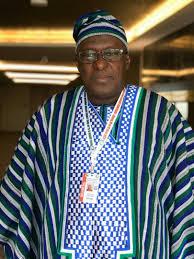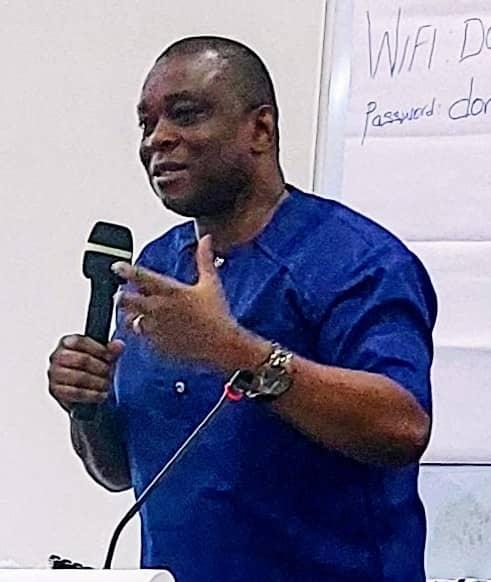New Fourah Bay College history published in Canada
The greatest breaking news for Fourah Bay College and Sierra Leoneans in general is the news about the publication in Canada of the long awaited and long sought for history about Fourah Bay College’s past, because for the first time in the 184 years of its existence the dream of educated Sierra Leoneans in particular and West Africans in general has come to reality. (Photo: author, Anthony K Kamara, Sr)
Fourah Bay College history, Black Africa’s first University College South of the Sahara has been published in Canada in response to calls from Sierra Leoneans including past students from around the globe. “A concise history of Fourah Bay College 1827-2003” authored by Anthony Karim Kamara (Sr), a Sierra Leonean National resident in Winnipeg, Manitoba in Canada, with a forward note by former University of Maryland’s Associate Professor of Mathematics and Statistics and Manager of Federal Research in Food and Nutrition Services and also current Presidential Adviser in charge of Strategic Planning and Research at State House Freetown Sheku Gibril Kamara (Ph.D), has been published by Art Bookbindery Publishing House in Canada and is the second such publication of its kind in the entire history of Fourah Bay College. The first published history of Fourah Bay College, “Jubilee and Centenary Volume of Fourah Bay College” (1930) was by Thomas Josiah Thompson a former student and Durham graduate from the Cline town campus. Since then FBC history has been in what can be likened to the “dark ages” in Europe when that continent experienced a paucity of written material. But with this publication, a “renaissance” period for Fourah Bay College’s past has begun. The new author himself a graduate from the Mount Aureol campus (1974), is re-awakening the rich heritage and forgotten or neglected history of the sub-region’s premier higher educational institution to make it readable and available and within the means of every educated national and believes FBC history must be revived from the state of dormancy it found itself and be part of Sierra Leone’s educational history. As a result, out of his passion and thirst to write and publish a FBC history for the benefit of all Sierra Leonean compatriots, the author feels morally compelled that someone has to take up the challenge of digging into and unearthing the forgotten past of an institution which has educated thousands of nationals along the West African coast, men who were at the forefront of the Nationalist Movements in the first quarter of the 20th century and thousands of Sierra Leoneans, otherwise the history of this once prestigious university college would have remained in its present state of darkness. The narrative is simple, concise but comprehensive in nature in which the author has brought back to memory 176 years of history (1827-2003) of the college. It is a very educative piece of history for all interested in learning about the past of this old institution.
Recent scholarly research however reveals that only one copy of T. J .Thompson’s “Jubilee and Centenary Volume of Fourah Bay College” survives today in the library of the University of Durham at New Castle Upon-Tyne in the United Kingdom. Since then there has been no attempt by anyone to write and publish the history of this “mother” of all Universities in Black Africa probably for want of historical data and other circumstances until now, in spite of the myriad of Fourah Bay College graduates and academics around the globe. This explains why Sierra Leoneans and former alumni of Anglophone West Africa have never sighted or picked up any copies of a book on FBC history from the shelves of any bookshop in Sierra Leone, not even from the FBC library on Mount Aureol which makes knowledge of the history of this former Durham affiliate university college murky and in a state of oblivion. This publication however is not tailored to suit the needs of any school syllabus local or external; it is simply history for the general knowledge of the Sierra Leonean mind and therefore must be seen as providing the panacea to the dearth of adequate information which had been wanting for too long.
In this new publication, the author traces the history of the College from its nascent period as a Christian Institution in Leicester (1814) to its relocation to the neighbouring mountain village of Regent, and its final closure in that village and, relocation and transformation to a College in 1827 and subsequent upgrade to university college status in Cline town in 1876. It should be seen as part of the colonial educational history of Sierra Leone. But in addition to the British colonial Government’s wish to see the failure and closure of the college, its repugnance and unwillingness to provide financial support to the existence of FBC and the London Times’ strident criticism of the CMS for starting a university college in a tiny Black African country like Sierra Leone, the author discusses the numerous challenges the college faced throughout its years of existence both before and after its relocation to Mount Aureol after World War 11, the various college administrations from Edward Jones, the First Principal, right up to the era of the Late Dr. Davidson Nicol, the first Sierra Leonean Principal and his successors; in particular, the book lucidly discusses among other topics, the first 112 years in the Cline town location, the reasons for naming the new college “Fourah Bay”, its six years of sojourn at Mabang Agricultural Academy during the inter war years (1939-45) and its post war relocation to Mount Aureol where it is permanently located today. He compares the origins of Fourah Bay College with those of two other private first universities like Harvard in the United States, and Oxford in the United Kingdom. He also referenced in addition to Fourah Bay College the other educational institutions like the former CMS Grammar School 1845 (now SL Grammar School), the Annie Walsh Memorial Girls’ School 1849 and the Methodist Boys’ High School 1874 and Methodist Girls High School, the St. Joseph’s Secondary School (1866): these 19th century educational institutions in Freetown all collectively earned Freetown the sobriquet “Athens of West Africa”, a city of great renown for scholarship where students from all Anglophone West Africa came to acquire higher education as was Athens in ancient times which was Europe’s renowned cultural centre for learning and philosophical studies, a land where great men like Socrates, Sophocles and many renowned philosophers, writers and politicians were born . The author clarifies and puts to rest the confusion among outsiders and some Sierra Leonean minds about the phrase “Athens of West Africa” which many educated Sierra Leoneans and some writers overseas, take to mean Fourah Bay College instead of the city of Freetown. The phrase simply likened the 19th century city of Freetown a university city (FBC and those early prestigious schools) to Athens in Ancient Greece, a renowned centre of learning generally considered to have been the cradle of western civilization, and home of Plato’s Academy and Aristotle’s Lyceum. Freetown, from this perspective, is West Africa’s cradle of Higher Education as well as Grammar School education, where West Africans came for secondary and post-secondary education.
Readers will be amazed to learn that up to the end of World War 1 (1914-18), Fourah Bay College actually had a Medical and Law Schools and was already producing graduates with Bachelor of Medicine, Bachelor of Surgery and Bachelor of Law degrees as well as running a Master’s degree program. These programs disappeared from the college after the War due to inadequate funding and continued attacks on the CMS by the British Colonial Authorities and other British groups only for these courses to be re-introduced in the 80s. The disappearance of these programs was one of the greatest setbacks FBC suffered in her years of existence and may also be seen as the genesis of the gradual decline in scholarship not only at FBC, but also in those 19th century high schools of the city. The first Medical and Law Schools would have been a source of immeasurable pride to every Sierra Leonean today. But here is FBC re-starting all over again instead of building upon what already existed and still facing the funding problems characteristic of the early 19th and 20th centuries. It was the colonial authorities’ lack of interest in FBC and stinginess that led to the closure of these faculties at FBC thereby forcing students like Sir Milton Margai who, after his first degree in 1921 had to travel to do his Master’s degree and Medical studies in England like his many compatriot Sierra Leonean professionals who were to follow his footsteps.
The nation of Sierra Leone and Anglophone West Africa in general must feel greatly indebted to the Church Missionary Society (CMS) for their steadfastness and efforts in spite of attacks by opponents and their resolve at starting the very first institution of this level at a time no one dreamt of such in the sub region or even in Black Africa otherwise, West Africa would have been educationally deprived of this history, considering the very late emergence of other first universities in West Africa 121 years after Fourah Bay College,- University of Ibadan in Nigeria (September 1948), the University of Ghana at Legon (also in 1948). This is history not only for the present generation of Sierra Leoneans and West Africans in general but also for generations to come.
Apart from the historical narrative, the book includes colourful photographic illustrations of all important visible heritage buildings of the college since 1827, including the original building at Cline town and its present ruins at the same location today, the Mabang Academy at Kholifa Mabang Chiefdom on the Ribbi river, The Arts Faculty and modern College library with the Mary Kingsley Theatre, the JF Kennedy tower, the Faculty of Pure and Applied Sciences, the Administration building, the College Chapel and Students’ Union building, the modern Strasser-King building, the Male and new Female students’ hostels, both wings of the Ajayi Crowther Amphitheatre, the UBA bank and Radio Mount Aureol, the ageing College Clinic, the ruins of Professor Harry Sawyerr’s residence at Harry Sawyerr hill. In short, the book reveals everything pertinent to Fourah Bay College in all its former and present locations. However, the thick foliage of trees made photographing the Principal’s mansion, Lati-Hyde female hostel and the Department of Education impossible to include. The author spent the first week of January this year visiting the Cline town, the Mabang and Mount Aureol campuses taking the colourful photographs included in this publication which, it is hoped will serve as a useful lifetime handbook for every educated Sierra Leonean and for all alumni in particular, a lifelong souvenir of their alma mater. It is history that should arouse interest in students and Sierra Leonean intellectuals alike, including retirees and stand the test of time. It is also important to mention that Fourah Bay College is the very first in Black Africa known to have produced two of its contemporary students both graduating the same year, turned politicians and have simultaneously become President of the nation and Leader of the main Opposition at the same time. This is no mean accomplishment.
Furthermore, the book includes photos of Sir Milton Margai, the first Prime Minister and the first from the former Protectorate to graduate from Fourah Bay College in 1921 from the Cline town campus and fifty-six years later President Ernest Bai Koroma, the second President from Northern Sierra Leone and the first graduate Head of State from Mount Aureol campus in 1976. Photographic images of Dr. Davidson Nicol at a university convocation ceremony with Queen Elizabeth 11 in 1962, (the Royal Visit Year), Professor and Reverend Harry Sawyerr and the Late Ethiopian Emperor Haile Selassie at a special convocation ceremony in 1972, Professor Eldred Jones, successor to Harry Sawyerr and Mrs Lati-Hyde Forster who made history as the first female student at FBC in 1945 on Mount Aureol and first female graduate (1949) and became not only the first Sierra Leonean but also the First African Principal of her alma mater, the Annie Walsh Memorial School (1961-1975) and the first to be named after a female hostel on Mount Aureol. The images and illuminating narrative makes this publication and the second only in the college’s history since 1930, compelling read for the Sierra Leonean reading public. In short the book has dealt exclusively with almost every aspect of Fourah Bay College history up to 2003 including the establishment of the Institute of African Studies initially headed by expatriate lecturers and later by Retired American History Professor and Head of the History Department John Peterson followed by two of his former students, Retired Professor Magbailey-Fyle and Arthur Abraham who made significant contributions to the study of local Sierra Leonean ethnic history, Fyle from 1975 to 1991, and Abraham from 1991 to 1994, the Fourah Bay College / Kalamazoo experience and exchange program which started in 1962. Therefore, every Sierra Leonean and FBC past and present students in particular deserve owning personal copies of this piece of history anytime it appears on the shelves of Freetown bookshops. The book is now available for sale from the author: however owing to the credible and reliable mailing and delivery systems in the Diaspora, Sierra Leoneans overseas including other areas of Africa may now place their orders direct from the author either by international money order or money Transfer, and communicate details by any of the under-mentioned electronic mails or call the number below : but Sierra Leoneans at home may have to wait until the book hits the Freetown bookstores in the coming months and plans are already in place for the shipment of a consignment to Freetown while negotiations are almost finalised for a local bookstore as sales agent. Until then, the author encourages all at home to exercise patience.
Readers may also visit: www.aconcisehistoryoffbc.com
The last chapter includes selections from complimentary comments from readers around the globe who inspired the writing of this book.
The book’s front cover page shows the Administration building (from Kortright hill) with inscription of the college logo and the green colour reflecting Fourah Bay College’s green colour. The old Cline town red stone-built Fourah Bay College building is also shown.
Price: US$20 + $5 (S&H) Canada: Cdn$20+$5 (S&H) Sierra Leone: US$10 or Leone equivalent. tonyram2@shaw.ca. akkram1704@gmail.com tonyram1@hotmail.ca Anthony Karim Kamara (Sr) FBC Adm. Register: 4941 Winnipeg, Canada. 1-(204) 269-6125By Anthony Karim Kamara (Sr) writes from Winnipeg, Canada.
Stay with Sierra Express Media, for your trusted place in news!
© 2011, https:. All rights reserved.








Emmanuel "Sheeley" Conteh, Mankato, MN
/
Mr. Kamara has done an excellent job in researching and writing not only a history of Fourah Bay College, but also of Sierra Leone. Like his predecessor, T.J. Thompson, Kamara also stretched far the same anaemic pride that Sierra Leone was the cradle of Western education (and by extension Western civilization)! This would all seem true on the face value, except there are cracks in this lame argument.
Let me be a bit cynical here when it comes to identifying Sierra Leone as the ‘Athens of West Africa’ because of the flurry of academic activities that characterized it in the 19th century. I would have to borrow from the post-modernist skepticism of Michel Foucault, Friedrich Nietzsche, Jacques Derrida and others to make my point. Attacking the self-evident truths’ argument of the 18th and 19th centuries, Foucault, Nietzche, Deridda and other post-modernists, asserted that the world and Europe in particular, wouldn’t have witnessed the extermination and concentration camps associated with the Nazi horrors of the 20th century. Basically, their argument was that Europe hadn’t yet attained civilization contrary to the claims made by proponents of self-evident truths!
It is in a similar vein that I intend to make my case that Sierra Leone was not and never was the ‘Athens of West Africa.’ If indeed it was the ‘Athens of West Africa’, how did its citizens end up decapitating and amputating one another? Why did its men engage in the recent wholesale rapes of its women? If there was an ‘Athens of West Africa’, we wouldn’t have had scumbags like Foday Sankoh, Sam ‘Moskitta’ Bockarie and others, or political thugs like Siaka Stevens, S.I. Koroma and others. We wouldn’t have had scoundrels like J.S. Momoh, Tejan Kabbah and others, nor bloody tyrants like Valentine Strasser, Maada Bio, S.A.J. Musa and Johnny Paul Koroma. This so-called ‘Athens of West Africa’ is nothing but a myth that British Colonialism foisted upon us to perpetuate a servile educational system! Alas, we’ve recycled this myth over the decades, instead of challenging and getting rid of it!
28th June 2011